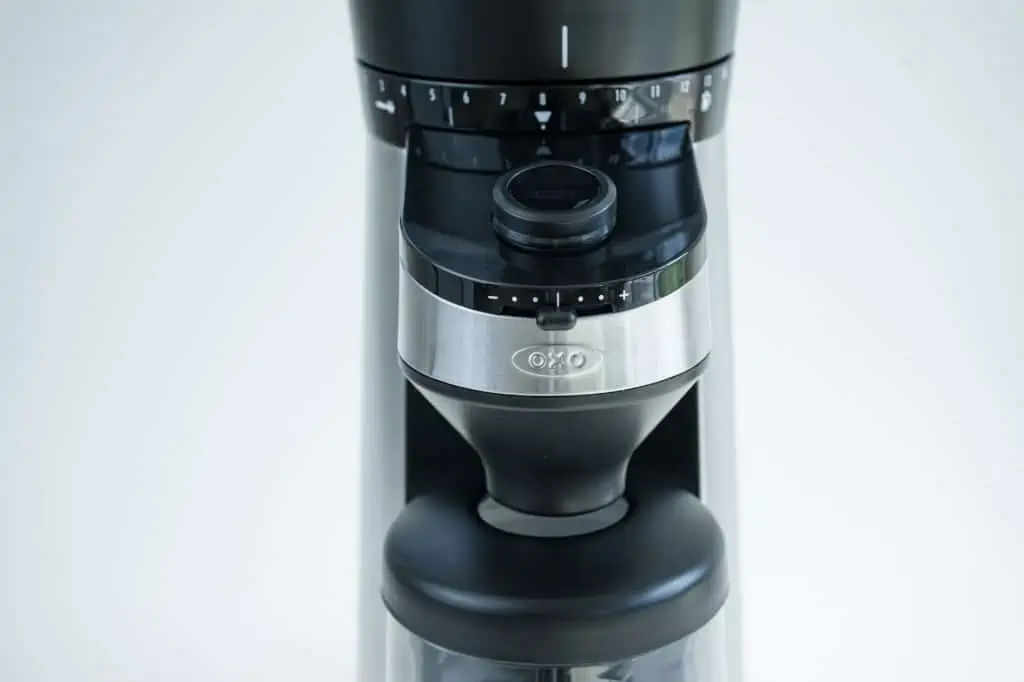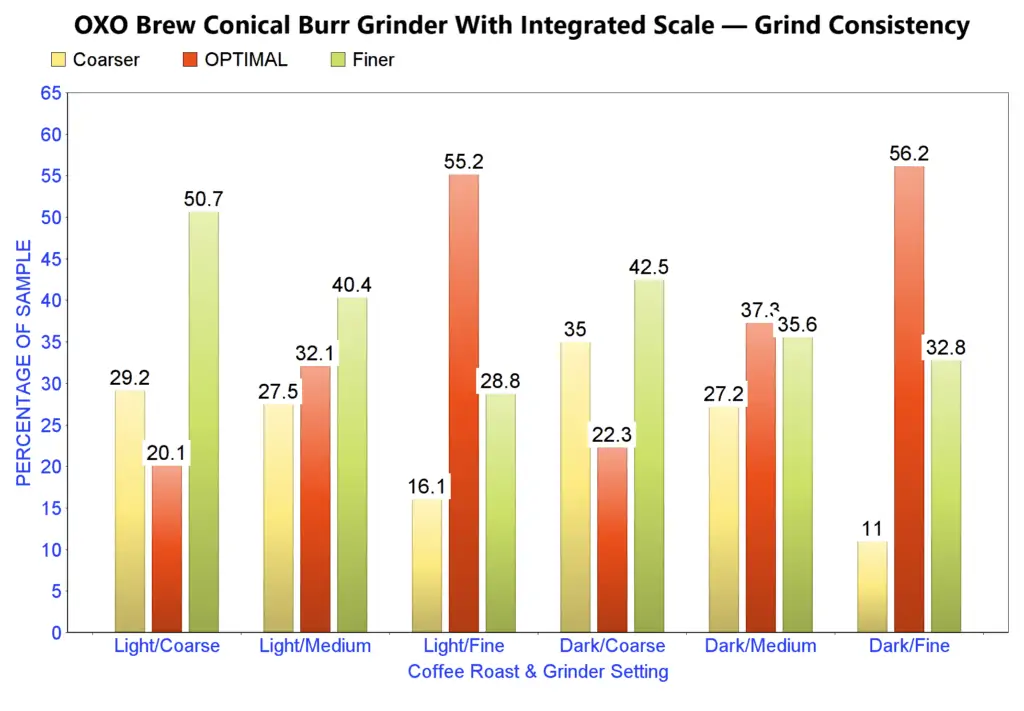
Overall Rating: 8.5
Pros: The Oxo offers admirable grind consistency and conveniently controls how much coffee is ground by weight rather than by time.
Cons: The weight of the actual dose always slightly misses the target. The unit’s high-pitched noise is on the louder side and its lightweight materials raise longevity concerns.
MSRP: $224.99
How to Interpret Equipment Ratings | Read complete report: Four Mid-Range Burr Coffee Grinders Tested & Reviewed
Reviewer’s Take:
Controlling grinding by weight is an exceptional feat for a grinder in this price bracket, and offers a major step up in precision for anyone whose coffee routine has to this point depended on scoops and eyeball estimates. Although the Oxo Brew’s automation of this feature results in doses less precise than they would be if weighed out by hand, the inaccuracy is not great and is relatively predictable.
Dose Accuracy. Tested using calibration weights, the Oxo scale itself proved perfectly accurate. It’s the grinder’s ability to slam on the brakes at a targeted weight of ground coffee that is consistently a few revolutions off the mark. After the system cuts power to the motor, momentum keeps the burrs in motion just long enough to allow an extra bit of ground coffee through to the bin.
Perhaps more troubling than the inaccuracy, though, is that the Oxo Brew’s screen does not reflect it. The screen shows the upward count from zero to the target in real time as grounds accumulate, then stops at the target even though more grounds almost always wind up on the scale. Unless you’re weighing the grounds again as you load them into a filter for brewing, you might never know the Oxo Brew’s doses typically land at least a gram heavier in most cases. In coarser grinds, the result is sometimes more than a gram beyond what you requested, and yet, in larger batches, it might actually land a gram shy.
While in principle this fuzziness is regrettable, in practice we grew to accept the +/-1g grey area pretty quickly in exchange for the mighty convenience of bypassing far less accurate systems that are controlled by a timer. Because weight, as opposed to volume, is always the more precise way to approach dosing coffee, the Oxo’s scale should attract folks who seek precision. Ironically, though, while the Oxo encourages meticulousness among people who may never have bothered to weigh their coffee before, Oxo’s slightly fuzzy measurements actually encourage already committed precision-minded users to relax and let a gram slide here and there, whether they know it or not.
Noise, Static and Build. Other aspects of the Oxo we found ourselves willing to let slide are its thin exterior materials and the loud, high-pitched whine of its motor in action, which we measured at roughly 92-97dB. Also, while it’s not the messiest grinder we tested, the Oxo, particularly when grinding darker and more static-prone roasts, will allow a dusting of grounds to escape the bin through the small space between its lid and the output chute.
Other observations: It’s not easy to pour from the wide-mouthed bin directly into single-cup or other small filters, and although Oxo seems to think its grinder can perform adequately for espresso brewing, our experience suggests it struggles to grind fine enough, and does not offer the kind of minute adjustability needed for espresso anyway, therefore making it better suited for brewed coffee (drip, French Press, etc.). When emptied out for cleaning, we found a little over 3 grams of coffee built up inside the machine; not the best, but not a bad performance as far as grounds retention goes.
Particle-Size Consistency. When balanced by budget-friendly access to a decent-enough grind-by-weight feature, none of these peccadillos really dragged the experience down. We draw a harder line at compromising where grind quality is concerned, but the Oxo largely stays on the better side of that line. We sent samples of two roasts ground at three different settings to our friends at Horiba Instruments for laser diffraction particle size analysis, and the Oxo Brew landed the second-best performance among the four grinders we review for this report. For detailed test results see the bar graph at the end of this review.
Of course the Oxo Brew’s grind consistency is nowhere near perfect, but no grinder is perfect in regard to uniformity. We’ve certainly seen more expensive grinders do worse. We’ve also seen grinders a little cheaper than the Oxo Brew do a bit better, like the Breville Smart Grinder Pro, also reviewed this month. Yet, so far as we can determine, no other machine in the Oxo Brew’s price class grinds by weight, and we didn’t realize just how seductive that built-in scale would be until we lived with it for a while.
The Bottom Line. Often when it comes to matters of convenience, the question is, do you want something done easily, or do you want it done right? While not a slam dunk, we find the Oxo Brew Conical Burr Grinder With Integrated Scale comes appreciably close to both.
Key Specifications:
Hopper Capacity: 16 ounces
Dimensions: H 16.4″, D 11.1″, W 7.3″
Weight: 7.4 pounds
Burrs: 40mm stainless steel conical
Burr Speed: 400 RPM
Grind Settings: 45
MSRP: $224.99
Manufacturer Website: www.oxo.com
 Grind consistency test results for the Oxo Brew Conical Burr Grinder with Integrated Scale based on laser particle size distribution analysis by Horiba Instruments. Six samples were tested from each grinder representing various grind settings (coarse, medium, fine) and two degrees of roast (light and medium-dark). Like other grinders we tested, the Oxo Brew was at its best producing fine grinds. For an explanation of how we determined our optimal range of particle sizes click here.
Grind consistency test results for the Oxo Brew Conical Burr Grinder with Integrated Scale based on laser particle size distribution analysis by Horiba Instruments. Six samples were tested from each grinder representing various grind settings (coarse, medium, fine) and two degrees of roast (light and medium-dark). Like other grinders we tested, the Oxo Brew was at its best producing fine grinds. For an explanation of how we determined our optimal range of particle sizes click here.










